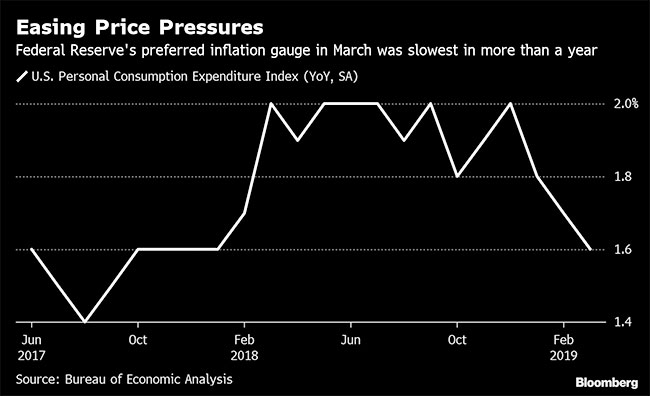March Consumer Spending Jumps as Core Inflation Eases

U.S. consumer spending rebounded in March while the Federal Reserve’s preferred underlying inflation gauge eased to a one-year low, reinforcing the central bank’s patient stance on interest rates even as the economy’s main engine holds up.
Purchases, which make up more than two-thirds of the economy, rose 0.9% in March from the prior month, topping estimates with the best gain in almost a decade, after a 0.1% February increase, according to a Commerce Department report April 29 that combined two months after delays related to the government shutdown. Personal income rose 0.1% in March, less than forecast.
Excluding food and energy, the Fed’s preferred core-price gauge was little changed from the previous month, compared with estimates for a 0.1% gain. The measure was up 1.6% from a year earlier, the slowest since January 2018 and missing projections. The broader personal consumption expenditures price index rose 0.2% in March from the previous month and climbed 1.5% from a year earlier, also below forecasts.
The signs of consumer strength follow the April 26 gross domestic product report showing consumer spending, the largest chunk of the economy, cooled in the first quarter to a 1.2% pace of gains. That was offset by boosts from inventories and trade that helped economic growth accelerate to a 3.2% annualized rate.
The below-forecast price data April 29 showed inflation still below the Fed’s 2% goal despite low unemployment and what most economists see as above-average growth. Policymakers on May 1 are expected to hold interest rates steady, though new growth and inflation data are likely to affect their characterization of the economy.

A broader question for the Fed and Chairman Jerome Powell — who will hold a press conference May 1 — is how low core inflation could go before the central bank cuts interest rates to maintain the credibility of the 2% goal for price gains. President Donald Trump has cited muted inflation as a reason for the Fed to ease monetary policy to keep economic growth strong.
Forecasts in the Bloomberg survey had called for March spending to increase 0.7% with incomes up 0.4%. Economists had forecast the annual inflation gauge would climb 1.6% while the core measure advanced 1.7%. Longer term projections point to the core gauge firming this year, to a 2% pace in the fourth quarter, the same as the median estimate by Fed policymakers in March.
The April 29 Commerce Department release included personal spending data for February and March. The earlier data were delayed because of the federal government shutdown that ended in January. The latest figures reflect a monthly breakdown of data already included in the April 26 GDP report.
While the main personal-income figure missed forecasts, wage and salary gains remained solid with a 0.4% monthly rise in March after a 0.3% increase in February. Lower interest income and farm payments dragged down the headline number, the Commerce Department said.




